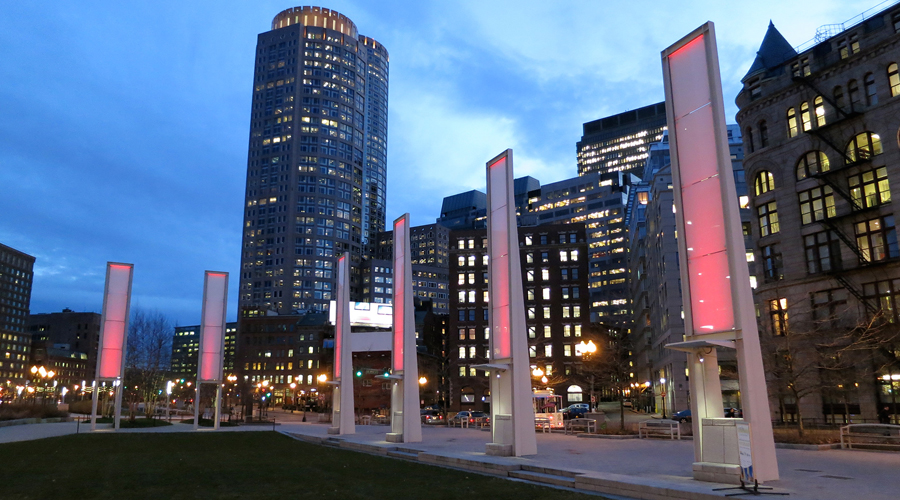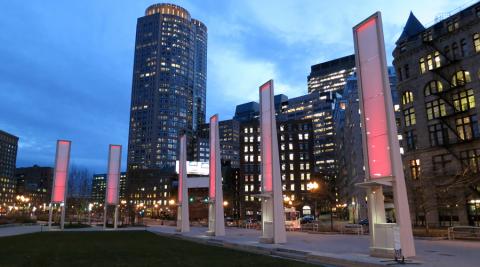The latest production of Public Art reaffirms the multifaceted identity of the contemporary metropolis. Artistic research, the observer and the city are linked by the transformation of the public space and its regeneration. The public sphere is one of the focal issues of contemporary culture that sees the city as a body, a fluid relationship, a metaphor of the complex multiplicity of the world. The New American Public Art group are interested to show a morphology in constant mutation, a dynamic socio-anthropological geography made of groups and communities in vital and vibrant relation. A horizon that now includes interactive processes of art, technology and participation.
Modesta Di Paola: Could you please introduce New American Public Art, its story, the space, and outline your main aims and activities? What was your initial motivation to start to work in public spaces?
Manifesting our namesake.
New American Public Art is a multi-disciplinary studio for conceptualizing, designing, fabricating, and installing interactive projects. NAPA began in 2010 as an effort to manifest its namesake through creating work with two simple rules: The work must be interactive. The work must be free to the public.
We want to live in a world where the public realm is filled with creativity and interaction. A world where shared civic space is created and shaped by its users, and artworks enable and encourage public communication and curiosity. To these ends we began New American Public Art.
M. D. P.: In your artistic conception, Public Art is as a catalyst to create opportunities for a dialogue between people of a community. How does your artistic research connect with your own desire about the city and its inhabitants?
Diversity is a positive force.
Some of the fundamental questions we ask ourselves are : “Why make public art? Why make it interactive? What is the effect on society? What is the effect on the individual? Why / how are these effects positive?” The answers to these questions are rooted in our hopes of ideal societies, our morals, and our ethics.
In general, we believe diversity is a positive force. Public art can make places diverse by creating a visual and cultural identity that is distinct from other places. Interactive public art furthers uniqueness and diversity by drawing out expression and humanity in the participants. Ideally, interaction with the art leads to a wealth of unique community interactions. These interactions between people have higher probability for encouraging creativity, meaning, and societal evolution.
M. D. P.: In what way do you think that your artistic public production impacts social life in the everyday activities?
Playing Social Instruments.
We want to give people a meaningful public experience which comes from their own actions and decisions. Since participants themselves have agency in the manifestation of the art, their experiences can create a sense of shared ownership. Shared ownership of public space is a cornerstone of community and open culture.
Many of our interactive works encourage public expression and creativity. We consider these pieces to be 'social instruments'. They are catalysts for people interacting with each other, and can be ‘played’ in a variety of ways.
Overall we hope that our public art instills in people the desire to make creative places. Places that are shared with friends and family. Places where one can feel the latent creativity and expressivity of the city bubble to the surface.
M. D. P.: Could you recall any works that was a challenge for you?
One week to make, one year to permit.
The most challenging part of any public art work is the permitting and permissions process. Color Commons, a piece where we transformed architectural-scale park lighting into a publicly interactive and accessible experience, took only a week to execute. However, the permit and permissions process lasted over a year.
M. D. P.: What is your vision for the future?
Animals first, cyborgs second.
As society and individuals become more integrated with technology, we are witnessing public spaces become less accessible, and yet highly customizable. Culture is progressing toward a technological class divide, where some people are privy to a multi-layered world of physical and digital information, and others are not.
It is our challenge as artists, architects, and programmers to design a future that is accessible to the human as an animal first and as a cyborg second. This is not a future devoid of technology by any means; it is a future where technology enhances our abilities as creative physical and social animals.
http://www.newamericanpublicart.com



